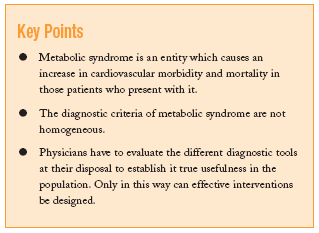Metabolic syndrome is a clinical entity defined as group of metabolic changes due to insulin resistance. This situation produces disorders of glucose metabolism, increases in blood pressure levels, lipid disorders, and obesity.1
A, still unclear, predisposing genetic component has been identified in its aetiology, along with a series of environmental factors, including those which are found in "classic" cardiovascular risk, such as central obesity, sedentary lifestyle, high calorie diet and smoking tobacco, and "emerging" factors, such as an increase in C reactive protein, increased fibrinogen and plasminogen activator inhibitor, high uric acid, leptin resistance, and high plasma cysteine.
The importance of metabolic syndrome lies in the increased probability of having cardiovascular complications in the long term. Its components are independent cardiovascular risk factors, and some--in particular obesity and insulin resistance--are factors which predispose the development of other risk factors, such as type 2 diabetes mellitus.
Although the absolute risk of cardiovascular complications in patients with metabolic syndrome has not been determined, there is data on the prevalence of coronary disease of approximately 14%2 in patients with metabolic syndrome, and there are studies that have shown morbidity and mortality figures considerably higher than the general population.3
Depending on the studies and the diagnostic method employed, the prevalence of metabolic syndrome in Spain varies between 24% and 30%, although more studies are required to be able to establish these figures with confidence. In this sense, the present study contributes by giving us more data by estimating the prevalence in its population.
Since we currently know not only the risk of cardiovascular complications of each of the separate components of metabolic syndrome, but also the efficacy of the interventions made on each of them,4 the need for timely detection of this entity and the design of appropriate interventions on the patients who present with it, with the aim of reducing the overall cardiovascular risk.
On this point, this study makes two very interesting contributions: on the one hand, it demonstrates the need to homogenise the diagnostic criteria of metabolic syndrome, by verifying the lack of concordance between those used by the different scientific groups. This fact has also been verified by other studies.
On the other hand, it studies the association of the variables which can predict insulin resistance--a metabolic anomaly involved in metabolic syndrome, in obesity, type 2 diabetes, and arteriosclerotic vascular disease--and verifies the diagnostic validity of these variables to be able to design future interventions on their population. Metabolic syndrome presents a good opportunity to fundamentally design specific interventions of lifestyle habits and drugs where necessary and personalised for each patient depending on their cardiovascular risk.
The fact that the prevention of cardiovascular complications still has a long way to go has to be reflected upon. And not just on the theoretical aspects, but also on the diagnostic and therapeutic applicability.
The abundance of guides and protocols--metabolic syndrome is a good example, but it also occurs to a lesser extent, in the case of hypertension or lipid disorders-- all completely rigorous and with the same aim, but with variations in diagnostic criteria and cut off points, it sometimes makes the daily task difficult in the clinical consultations, particularly in overburdened care situations.
The quality achieved, as regards scientific education and technical training in the last few years has to be accompanied by suitable performance and interventions that really serve to improve the health of the population in our care. In this sense, it is worth remembering the fact that, despite having the knowledge and means necessary to control cardiovascular risk factors, the patients are not always diagnosed or suitably controlled.5,6
It is good that the initiative to evaluate the diagnostic and therapeutic usefulness of the different tools that evidence based medicine puts within our reach should come from the clinics themselves, to be able to design interventions suitable for the real population, with specific and real characteristics and needs.
Only then can the final objective of our work be accomplished, which is to improve the health of the people in our care.









